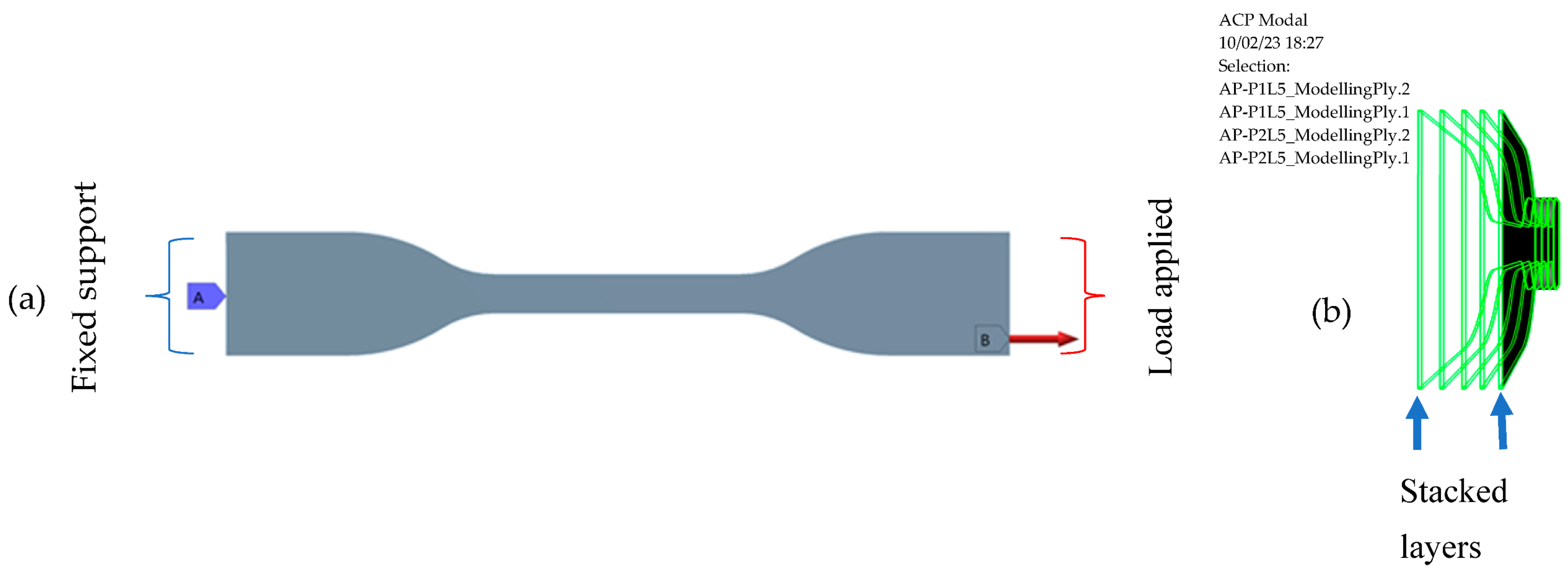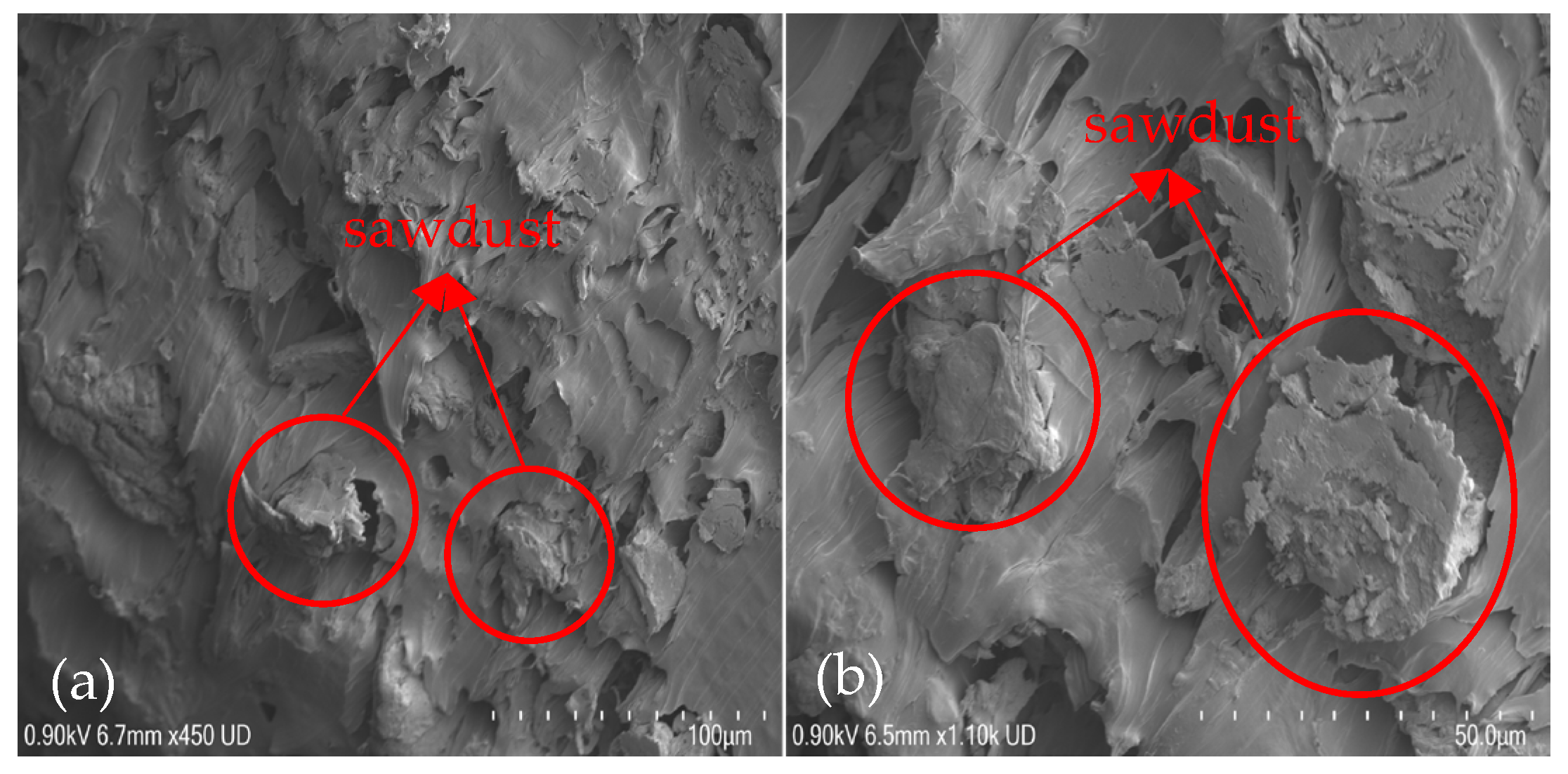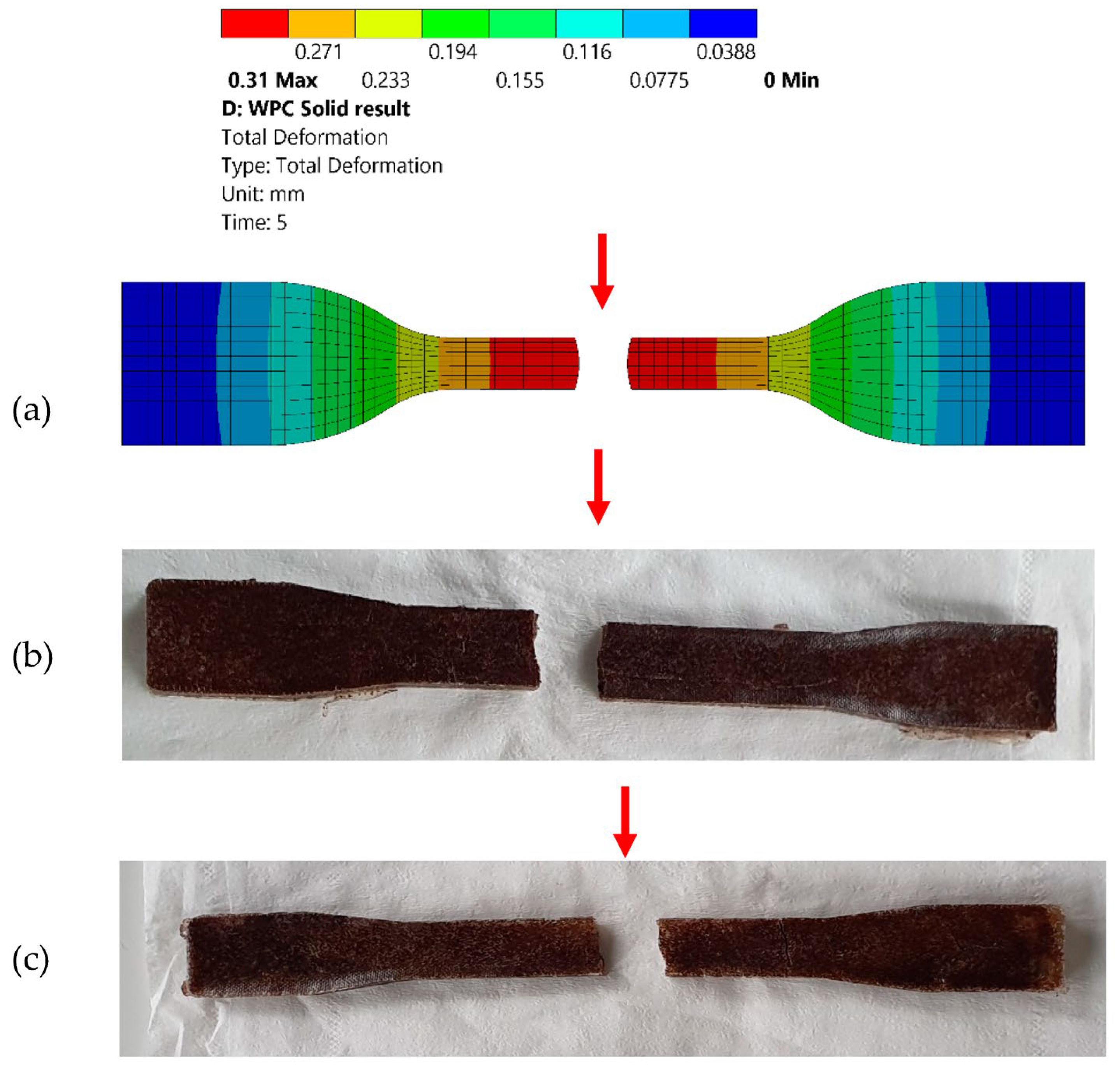Simulation of Wood Polymer Composites with Finite Element Analysis
Abstract
1. Introduction
2. Materials and Methods
2.1. Materials
2.2. Methodology
2.3. Tensile Test
2.4. Microstructural Analysis
2.5. Simulation
3. Results and Discussion
3.1. Morphology
3.2. Mesh Generation
3.3. Mechanical Properties
3.3.1. Stress and Strain Distributions
3.3.2. Deformation
4. Conclusions
Author Contributions
Funding
Institutional Review Board Statement
Informed Consent Statement
Data Availability Statement
Conflicts of Interest
References
- Roy, H.; Pahlevani, F.; Cholake, S.; Echeverria, C.; Banerjee, A.; Sahajwalla, V. Simulation of marine bio-composite using empirical data combined with finite element technique. J. Compos. Sci. 2018, 2, 48. [Google Scholar] [CrossRef]
- Echeverria, C.; Pahlevani, F.; Gaikwad, V.; Sahajwalla, V. The effect of microstructure, filler load and surface adhesion of marine bio-fillers, in the performance of Hybrid Wood-Polypropylene Particulate Bio-composite. J. Clean. Prod. 2017, 154, 284–294. [Google Scholar] [CrossRef]
- Ashori, A.; Matini Behzad, H.; Tarmian, A. Effects of chemical preservative treatments on durability of wood flour/HDPE composites. Compos. Part B Eng. 2013, 47, 308–313. [Google Scholar] [CrossRef]
- Chan, C.M.; Vandi, L.J.; Pratt, S.; Halley, P.; Richardson, D.; Werker, A.; Laycock, B. Composites of Wood and Biodegradable Thermoplastics: A Review. Polym. Rev. 2018, 58, 444–494. [Google Scholar] [CrossRef]
- Kalali, E.N.; Zhang, L.; Shabestari, M.E.; Croyal, J.; Wang, D.-Y.Y.; Naderikalali, E.; Zhang, L.; Entezar, M.; Croyal, J.; Wang, D.-Y.Y. Flame-retardant wood polymer composites (WPCs) as potential fire safe bio-based materials for building products: Preparation, flammability and mechanical properties. Fire Saf. J. 2017, 107, 210–216. [Google Scholar] [CrossRef]
- Kakarla, A.B.; Nukala, S.G.; Kong, I. Biodegradable materials. In Materials for Lightweight Constructions; CRC Press: Boca Raton, FL, USA, 2022; pp. 161–190. [Google Scholar]
- Oksman, K. Mechanical Properties of Natural Fibre Mat Reinforced Thermoplastic. Appl. Compos. Mater. 2000, 7, 403–414. [Google Scholar] [CrossRef]
- Väntsi, O.; Kärki, T. Environmental assessment of recycled mineral wool and polypropylene utilised in wood polymer composites. Resour. Conserv. Recycl. 2015, 104, 38–48. [Google Scholar] [CrossRef]
- Jubinville, D.; Esmizadeh, E.; Tzoganakis, C.; Mekonnen, T. Thermo-mechanical recycling of polypropylene for the facile and scalable fabrication of highly loaded wood plastic composites. Compos. Part B Eng. 2021, 219, 108873. [Google Scholar] [CrossRef]
- Moreno, D.D.P.; de Camargo, R.V.; dos Santos Luiz, D.; Branco, L.T.P.; Grillo, C.C.; Saron, C. Composites of Recycled Polypropylene from Cotton Swab Waste with Pyrolyzed Rice Husk. J. Polym. Environ. 2021, 29, 350–362. [Google Scholar] [CrossRef]
- Burgada, F.; Fages, E.; Quiles-Carrillo, L.; Lascano, D.; Ivorra-Martinez, J.; Arrieta, M.P.; Fenollar, O. Upgrading Recycled Polypropylene from Textile Wastes in Wood Plastic Composites with Short Hemp Fiber. Polymers 2021, 13, 1248. [Google Scholar] [CrossRef]
- Rahman, K.S.; Islam, M.N.; Rahman, M.M.; Hannan, M.O.; Dungani, R.; Khalil, H.P.S.A. Flat-pressed wood plastic composites from sawdust and recycled polyethylene terephthalate (PET): Physical and mechanical properties. Springerplus 2013, 2, 629. [Google Scholar] [CrossRef]
- Mo, X.; Zhang, X.; Fang, L.; Zhang, Y. Research Progress of Wood-Based Panels Made of Thermoplastics as Wood Adhesives. Polymers 2021, 14, 98. [Google Scholar] [CrossRef]
- Gill, Y.Q.; Abid, U.; Irfan, M.S.; Saeed, F.; Shakoor, A.; Firdaus, A. Fabrication, Characterisation, and Machining of Polypropylene/Wood Flour Composites. Arab. J. Sci. Eng. 2022, 47, 5973–5983. [Google Scholar] [CrossRef]
- Diouf, P.M.; Thiandoume, C.; Abdulrahman, S.T.; Ndour, O.; Jibin, K.P.; Maria, H.J.; Thomas, S.; Tidjani, A. Mechanical and rheological properties of recycled high-density polyethylene and ronier palm leaf fiber based biocomposites. J. Appl. Polym. Sci. 2022, 139, 51713. [Google Scholar] [CrossRef]
- Ilyas, R.A.; Zuhri, M.Y.M.; Aisyah, H.A.; Asyraf, M.R.M.; Hassan, S.A.; Zainudin, E.S.; Sapuan, S.M.; Sharma, S.; Bangar, S.P.; Jumaidin, R.; et al. Natural Fiber-Reinforced Polylactic Acid, Polylactic Acid Blends and Their Composites for Advanced Applications. Polymers 2022, 14, 202. [Google Scholar] [CrossRef]
- Mirowski, J.; Oliwa, R.; Oleksy, M.; Tomaszewska, J.; Ryszkowska, J.; Budzik, G. Poly(vinyl chloride) Composites with Raspberry Pomace Filler. Polymers 2021, 13, 1079. [Google Scholar] [CrossRef]
- Mirski, R.; Dukarska, D.; Walkiewicz, J.; Derkowski, A. Waste Wood Particles from Primary Wood Processing as a Filler of Insulation PUR Foams. Materials 2021, 14, 4781. [Google Scholar] [CrossRef]
- Sanvezzo, P.B.; Branciforti, M.C. Recycling of industrial waste based on jute fiber-polypropylene: Manufacture of sustainable fiber-reinforced polymer composites and their characterisation before and after accelerated aging. Ind. Crops Prod. 2021, 168, 113568. [Google Scholar] [CrossRef]
- Da Ferreira, E.S.B.; Luna, C.B.B.; Araújo, E.M.; Siqueira, D.D.; Wellen, R.M.R. Polypropylene/wood powder composites: Evaluation of PP viscosity in thermal, mechanical, thermomechanical, and morphological characters. J. Thermoplast. Compos. Mater. 2022, 35, 71–92. [Google Scholar] [CrossRef]
- Venkatesh, G.S.; Deb, A.; Karmarkar, A.; Gurumoorthy, B. Eco-Friendly Wood Polymer Composites for Sustainable Design Applications. In CIRP Design 2012; Springer: London, UK, 2013; pp. 399–408. [Google Scholar]
- Petchwattana, N.; Covavisaruch, S.; Sanetuntikul, J. Recycling of wood–plastic composites prepared from poly(vinyl chloride) and wood flour. Constr. Build. Mater. 2012, 28, 557–560. [Google Scholar] [CrossRef]
- Ayrilmis, N.; Jarusombuti, S.; Fueangvivat, V.; Bauchongkol, P. Effect of thermal-treatment of wood fibres on properties of flat-pressed wood plastic composites. Polym. Degrad. Stab. 2011, 96, 818–822. [Google Scholar] [CrossRef]
- Ameen, M. Boundary Element Analysis: Theory and Programming; CRC Press: Boca Raton, FL, USA, 2001; ISBN 0849310016. [Google Scholar]
- Dickson, A.N.; Barry, J.N.; McDonnell, K.A.; Dowling, D.P. Fabrication of continuous carbon, glass and Kevlar fibre reinforced polymer composites using additive manufacturing. Addit. Manuf. 2017, 16, 146–152. [Google Scholar] [CrossRef]
- Caminero, M.A.; Chacón, J.M.; García-Moreno, I.; Rodríguez, G.P. Impact damage resistance of 3D printed continuous fibre reinforced thermoplastic composites using fused deposition modelling. Compos. Part B Eng. 2018, 148, 93–103. [Google Scholar] [CrossRef]
- Alharbi, M.; Kong, I.; Patel, V.I. Simulation of uniaxial stress–strain response of 3D-printed polylactic acid by nonlinear finite element analysis. Appl. Adhes. Sci. 2020, 8, 5. [Google Scholar] [CrossRef]
- Bhandari, S.; Lopez-Anido, R. Finite element analysis of thermoplastic polymer extrusion 3D printed material for mechanical property prediction. Addit. Manuf. 2018, 22, 187–196. [Google Scholar] [CrossRef]
- Mothilal, T.; Ragothaman, G.; Manuel, D.J.; Socrates, S.; Mathavan, S.; Bhaskar, K.; Jayabalakrishnan, D.; Vinoth Kumar, M.; Sendilvelan, S.; Prabhahar, M. Analysis on mechanical properties of wood plastic composite. Mater. Today Proc. 2020, 45, 5886–5891. [Google Scholar] [CrossRef]
- Ezzaraa, I.; Ayrilmis, N.; Abouelmajd, M.; Kuzman, M.K.; Bahlaoui, A.; Arroub, I.; Bengourram, J.; Lagache, M.; Belhouideg, S. Numerical Modeling Based on Finite Element Analysis of 3D-Printed Wood-Polylactic Acid Composites: A Comparison with Experimental Data. Forests 2023, 14, 95. [Google Scholar] [CrossRef]
- Hartmann, R.; Puch, F. Numerical Simulation of the Deformation Behavior of Softwood Tracheids for the Calculation of the Mechanical Properties of Wood–Polymer Composites. Polymers 2022, 14, 2574. [Google Scholar] [CrossRef]
- Nukala, S.G.; Kong, I.; Kakarla, A.B.; Kong, W.; Kong, W. Development of Wood Polymer Composites from Recycled Wood and Plastic Waste: Thermal and Mechanical Properties. J. Compos. Sci. 2022, 6, 194. [Google Scholar] [CrossRef]
- Medupin, R. Mechanical Properties of Wood Waste Reinforced Polymer Matrix Composites. Am. Chem. Sci. J. 2013, 3, 507–513. [Google Scholar] [CrossRef]
- Nukala, S.G.; Kong, I.; Kakarla, A.B.; Tshai, K.Y.; Kong, W. Preparation and Characterisation of Wood Polymer Composites Using Sustainable Raw Materials. Polymers 2022, 14, 3183. [Google Scholar] [CrossRef]
- Najafi, S.K.; Hamidinia, E.; Tajvidi, M. Mechanical properties of composites from sawdust and recycled plastics. J. Appl. Polym. Sci. 2006, 100, 3641–3645. [Google Scholar] [CrossRef]
- American Society for Testing and Materials. Standard Test Method for Tensile Properties of Plastics 1; American Society for Testing and Materials: West Conshohocken, PA, USA, 2006. [Google Scholar]
- Reddy, G.; Krishna, V.; Shanker, K. Tensile and Water Absorption Properties of FRP Composite Laminates without Voids and with Voids. Procedia Eng. 2017, 173, 1684–1691. [Google Scholar] [CrossRef]
- Sood, A.; Ramarao, S.; Carounanidy, U. Influence of different crosshead speeds on diametral tensile strength of a methacrylate based resin composite: An in-vitro study. J. Conserv. Dent. 2015, 18, 214–217. [Google Scholar] [CrossRef]
- Kim, D.B.; Lee, G.T.; Lee, I.H.; Cho, H.Y. Finite Element Analysis for Fracture Criterion of PolyJet Materials. J. Korean Soc. Manuf. Process Eng. 2015, 14, 134–139. [Google Scholar] [CrossRef][Green Version]
- Nukala, S.G.; Kong, I.; Patel, V.I.; Kakarla, A.B.; Kong, W.; Buddrick, O. Development of Biodegradable Composites Using Polycaprolactone and Bamboo Powder. Polymers 2022, 14, 4169. [Google Scholar] [CrossRef]
- Ratanawilai, T.; Taneerat, K. Alternative polymeric matrices for wood-plastic composites: Effects on mechanical properties and resistance to natural weathering. Constr. Build. Mater. 2018, 172, 349–357. [Google Scholar] [CrossRef]
- Dhal, J.P.; Mishra, S.C. Processing and Properties of Natural Fiber-Reinforced Polymer Composite. J. Mater. 2013, 2013, 297213. [Google Scholar] [CrossRef]
- Waqas, H.M.; Shi, D.; Imran, M.; Khan, S.Z.; Fathallah, E.; Helal, M. Design Optimization Of Composite Wood Sandwiched Submersible Pressure Hulls. J. Appl. Sci. Eng. 2022, 26, 1295–1304. [Google Scholar] [CrossRef]
- Fracz, W.; Janowski, G. Strength Analysis of Molded Pieces Produced from Wood-Polymer Composites (Wpc) Including Their Complex Structures. Compos. Theory Pract. 2016, 16, 260–265. [Google Scholar]
- Nithiyakumar, M.; Gopalakrishnan, D. Development and analysis of jute and coir reinforced composites. Textile 2007, 2348. [Google Scholar]
- Abbas, S.J.; Ali, M.M.; Al-Mosawi, A.I. Using of Ansys Program to Calculate the Mechanical Properties of Advanced Fibers Reinforced Composite. Iraqi J. Mech. Mater. Eng. 2012, 12, 673–679. [Google Scholar]
- Mohapatra, R.; Mishra, A.; Choudhury, B. Determination of thermal conductivity of pine wood dust filled epoxy composites. Therm. Sci. 2017, 21, 199–210. [Google Scholar] [CrossRef]
- Stasiak, M.; Molenda, M.; Bańda, M.; Gondek, E. Mechanical properties of sawdust and woodchips. Fuel 2015, 159, 900–908. [Google Scholar] [CrossRef]
- Soury, E.; Behravesh, A.H.; Rouhani Esfahani, E.; Zolfaghari, A. Design, optimisation and manufacturing of wood-plastic composite pallet. Mater. Des. 2009, 30, 4183–4191. [Google Scholar] [CrossRef]
- Horabik, J.; Bańda, M.; Józefaciuk, G.; Adamczuk, A.; Polakowski, C.; Stasiak, M.; Parafiniuk, P.; Wiącek, J.; Kobyłka, R.; Molenda, M. Breakage strength of wood sawdust pellets: Measurements and modelling. Materials 2021, 14, 3273. [Google Scholar] [CrossRef]
- Kakarla, A.B.; Kong, I.; Nukala, S.G.; Kong, W. Mechanical Behaviour Evaluation of Porous Scaffold for Tissue-Engineering Applications Using Finite Element Analysis. J. Compos. Sci. 2022, 6, 46. [Google Scholar] [CrossRef]
- Faridmehr, I.; Hanim Osman, M.; Bin Adnan, A.; Farokhi Nejad, A.; Hodjati, R.; Amin Azimi, M. Correlation between Engineering Stress-Strain and True Stress-Strain Curve. Am. J. Civ. Eng. Archit. 2014, 2, 53–59. [Google Scholar] [CrossRef]
- Adhikary, K.B.; Pang, S.; Staiger, M.P. Dimensional stability and mechanical behaviour of wood–plastic composites based on recycled and virgin high-density polyethylene (HDPE). Compos. Part B Eng. 2008, 39, 807–815. [Google Scholar] [CrossRef]
- Renner, K.; Móczó, J.; Pukánszky, B. Deformation and failure of PP composites reinforced with lignocellulosic fibers: Effect of inherent strength of the particles. Compos. Sci. Technol. 2009, 69, 1653–1659. [Google Scholar] [CrossRef]
- Barbero, E.J.; Shahbazi, M. Determination of material properties for ANSYS progressive damage analysis of laminated composites. Compos. Struct. 2017, 176, 768–779. [Google Scholar] [CrossRef]
- Martinez, X.; Oller, S. Numerical Simulation of Matrix Reinforced Composite Materials Subjected to Compression Loads. Arch. Comput. Methods Eng. 2009, 16, 357–397. [Google Scholar] [CrossRef]
- Oliver, J. A consistent characteristic length for smeared cracking models. Int. J. Numer. Methods Eng. 1989, 28, 461–474. [Google Scholar] [CrossRef]
- Frey, P.J. Generation and adaptation of computational surface meshes from discrete anatomical data. Int. J. Numer. Methods Eng. 2004, 60, 1049–1074. [Google Scholar] [CrossRef]
- Martinez, X.; Oller, S.; Barbu, L.G.; Barbat, A.H.; de Jesus, A.M.P. Analysis of Ultra Low Cycle Fatigue problems with the Barcelona plastic damage model and a new isotropic hardening law. Int. J. Fatigue 2015, 73, 132–142. [Google Scholar] [CrossRef]
- Burkhart, T.A.; Andrews, D.M.; Dunning, C.E. Finite element modeling mesh quality, energy balance and validation methods: A review with recommendations associated with the modeling of bone tissue. J. Biomech. 2013, 46, 1477–1488. [Google Scholar] [CrossRef]
- Zambaldi, E.; Magalhães, R.R.; Dias, M.C.; Mendes, L.M.; Tonoli, G.H.D. Numerical simulation of poly(lactic acid) polymeric composites reinforced with nanofibrillated cellulose for industrial applications. Polym. Eng. Sci. 2022, 62, 4043–4054. [Google Scholar] [CrossRef]
- Charupeng, N.; Kunthong, P. A novel finite element algorithm for predicting the elastic properties of wood fibers. Int. J. Comput. Mater. Sci. Eng. 2022, 11, 2150027. [Google Scholar] [CrossRef]
- Guo, Z.; Shi, X.; Chen, Y.; Chen, H.; Peng, X.; Harrison, P. Mechanical modeling of incompressible particle-reinforced neo-Hookean composites based on numerical homogenisation. Mech. Mater. 2014, 70, 17. [Google Scholar] [CrossRef]
- Bucki, M.; Lobos, C.; Payan, Y.; Hitschfeld, N. Jacobian-based repair method for finite element meshes after registration. Eng. Comput. 2011, 27, 285–297. [Google Scholar] [CrossRef]
- Bucki, M.; Lobos, C.; Payan, Y. A fast and robust patient specific Finite Element mesh registration technique: Application to 60 clinical cases. Med. Image Anal. 2010, 14, 303–317. [Google Scholar] [CrossRef] [PubMed][Green Version]
- Madeo, A.; Casciaro, R.; Zagari, G.; Zinno, R.; Zucco, G. A mixed isostatic 16 dof quadrilateral membrane element with drilling rotations, based on Airy stresses. Finite Elem. Anal. Des. 2014, 89, 52–66. [Google Scholar] [CrossRef]
- Tiwari, S.K.; Umamaheswara Rao, A.; Reddy, N.; Sharma, H.; Pandey, J.K. Synthesis, characterisation and finite element analysis of polypropylene composite reinforced by jute and carbon fiber. Mater. Today Proc. 2021, 46, 10884–10891. [Google Scholar] [CrossRef]
- Das Lala, S.; Sadikbasha, S.; Deoghare, A.B. Prediction of elastic modulus of polymer composites using Hashin–Shtrikman bound, mean field homogenisation and finite element technique. Proc. Inst. Mech. Eng. Part C J. Mech. Eng. Sci. 2020, 234, 1653–1659. [Google Scholar] [CrossRef]
- Navaneethakrishnan, G.; Karthikeyan, T.; Saravanan, S.; Selvam, V.; Parkunam, N.; Sathishkumar, G.; Jayakrishnan, S. Structural analysis of natural fiber reinforced polymer matrix composite. Mater. Today Proc. 2020, 21, 7–9. [Google Scholar] [CrossRef]
- Shih, Y.-F.; Huang, C.-C.; Chen, P.-W. Biodegradable green composites reinforced by the fiber recycling from disposable chopsticks. Mater. Sci. Eng. A 2010, 527, 1516–1521. [Google Scholar] [CrossRef]
- Satyanarayana, K.G.; Sukumaran, K.; Mukherjee, P.S.; Pavithran, C.; Pillai, S.G.K. Natural fibre-polymer composites. Cem. Concr. Compos. 1990, 12, 117–136. [Google Scholar] [CrossRef]
- Fang, H.; Sun, H.; Liu, W.; Wang, L.; Bai, Y.; Hui, D. Mechanical performance of innovative GFRP-bamboo-wood sandwich beams: Experimental and modelling investigation. Compos. Part B Eng. 2015, 79, 182–196. [Google Scholar] [CrossRef]
- Appadurai, M.; Raj, E.F.I.; LurthuPushparaj, T. Sisal fiber-reinforced polymer composite-based small horizontal axis wind turbine suited for urban applications—A numerical study. Emergent Mater. 2022, 5, 565–578. [Google Scholar] [CrossRef]
- Haftkhani, A.R.; Chavooshi, A.; Arabi, M. Simulation and prediction of bending performance of wood plastic composite profiles using finite element method by ANSYS Workbench software. Iran. J. Wood Pap. Ind. 2022, 13, 325–344. [Google Scholar]






| Composites | rPP (wt.%) | SD (wt.%) |
|---|---|---|
| rPP-SD3 | 70 | 30 |
| rPP-SD4 | 60 | 40 |
Disclaimer/Publisher’s Note: The statements, opinions and data contained in all publications are solely those of the individual author(s) and contributor(s) and not of MDPI and/or the editor(s). MDPI and/or the editor(s) disclaim responsibility for any injury to people or property resulting from any ideas, methods, instructions or products referred to in the content. |
© 2023 by the authors. Licensee MDPI, Basel, Switzerland. This article is an open access article distributed under the terms and conditions of the Creative Commons Attribution (CC BY) license (https://creativecommons.org/licenses/by/4.0/).
Share and Cite
Nukala, S.G.; Kong, I.; Kakarla, A.B.; Patel, V.I.; Abuel-Naga, H. Simulation of Wood Polymer Composites with Finite Element Analysis. Polymers 2023, 15, 1977. https://doi.org/10.3390/polym15091977
Nukala SG, Kong I, Kakarla AB, Patel VI, Abuel-Naga H. Simulation of Wood Polymer Composites with Finite Element Analysis. Polymers. 2023; 15(9):1977. https://doi.org/10.3390/polym15091977
Chicago/Turabian StyleNukala, Satya Guha, Ing Kong, Akesh Babu Kakarla, Vipulkumar Ishvarbhai Patel, and Hossam Abuel-Naga. 2023. "Simulation of Wood Polymer Composites with Finite Element Analysis" Polymers 15, no. 9: 1977. https://doi.org/10.3390/polym15091977
APA StyleNukala, S. G., Kong, I., Kakarla, A. B., Patel, V. I., & Abuel-Naga, H. (2023). Simulation of Wood Polymer Composites with Finite Element Analysis. Polymers, 15(9), 1977. https://doi.org/10.3390/polym15091977









